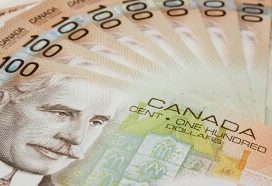Home / Forex news / Canadian Dollar Falls As Crude Oil Slumps, Keystone XL Pipeline Canceled

The Canadian dollar is weakening against its US peer to finish the trading week, paring most of its gains from recent sessions. The loonie is slumping amid declining crude oil prices and developments on the Keystone XL pipeline front. But positive economic data offset some of the bearish news. Could the currency’s push over the last several months come to a screeching halt?
According to Statistics Canada, retail sales advanced 1.3% in November, beating the market forecast of 0.1%. The retail trade reported gains in food and beverage and e-commerce, but declines for motor vehicles and automobile parts. On an annualized basis, retail sales surged 7.3% in November. Advanced estimates suggest retail sales slumped 2.6% last month.
Wholesale sales tumbled 1.7% in December, snapping a seven-month streak of gains. The statistics agency reported lower sales for machinery, equipment, supplies, and miscellaneous subsectors.
Earlier this week, it was reported that manufacturing sales dropped 0.6% in November. New housing prices jumped 0.3% last month. The consumer price index (CPI) fell 0.2% in December, but the inflation rate climbed 0.7% year-over-year.
On Wednesday, the Bank of Canada (BoC) held its first monetary policy meeting of 2021. Policymakers left interest rates unchanged at 0.25% and maintained the central bank’s quantitative easing program of $4 billion per week. The BoC forecast that the Canadian economy would contract in the first quarter but rebound in the second quarter. Overall, officials anticipate that the economy will expand 4% this year and grow another 4.8% in 2022.
BoC Governor Tiff Macklem warned that the country is “moving in the wrong direction right now, so the hole is going to be a little bit deeper,” adding that a stronger loonie could throw a wrench in the economic recovery.
Canadaâs economy had strong momentum through to late 2020, but the resurgence of cases and the reintroduction of lockdown measures are a serious setback.
The outlook for Canada is now stronger and more secure than in the October projection, thanks to earlier-than-expected availability of vaccines and significant ongoing policy stimulus.
The loonie is getting hammered by slumping energy prices. March West Texas Intermediate (WTI) crude oil futures fell $0.69, or 1.3%, to $52.44 per barrel. March natural gas futures slipped $0.029, or 1.16%, to $2.468 per million British thermal units (btu).
Canada maintains a current account deficit, so the national economy relies on exports for growth. Since oil and gas remain the country’s top exports, any price change can impact the loonie and the broader economy.
Meanwhile, on the political front, President Joe Biden recently put the kibosh on the Keystone XL pipeline system that would have mostly transported crude from Alberta to Texas. Prime Minister Justin Trudeau promised to speak with Biden about the situation during the presidentâs first telephone call with a foreign leader. The Keystone has been a contentious project for both Canada and the US, despite its enormous economic benefits for each country.
The bond market was mostly in the red to close out the trading week, with the benchmark 10-year bond tumbling 0.029% to 0.844%. The one-year note rose 0.015% to 0.135%, while the 30-year bond slid 0.024% to 1.476%.
The USD/CAD currency pair surged 0.77% to 1.2737, from an opening of 1.2637, at 17:49 GMT on Friday. The EUR/CAD soared 0.75% to 1.5496, from an opening of 1.5375.
If you have any questions, comments, or opinions regarding the Canadian Dollar, feel free to post them using the commentary form below.
Original from: www.earnforex.com
No Comments on “Canadian Dollar Falls As Crude Oil Slumps, Keystone XL Pipeline Canceled”